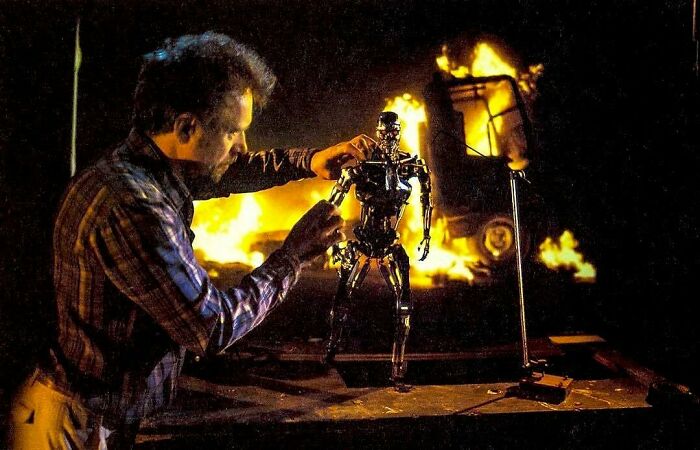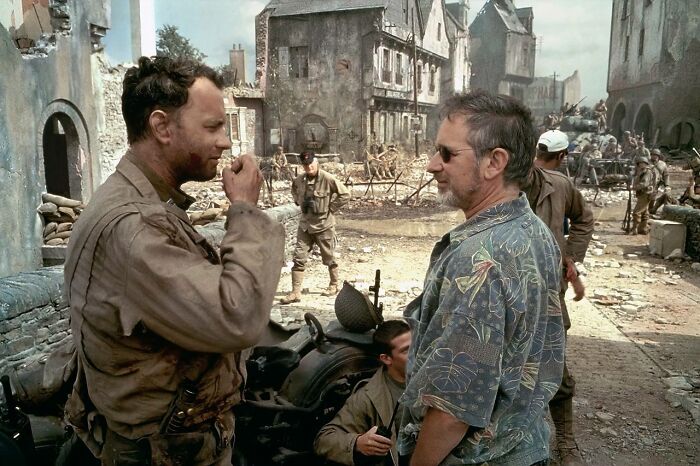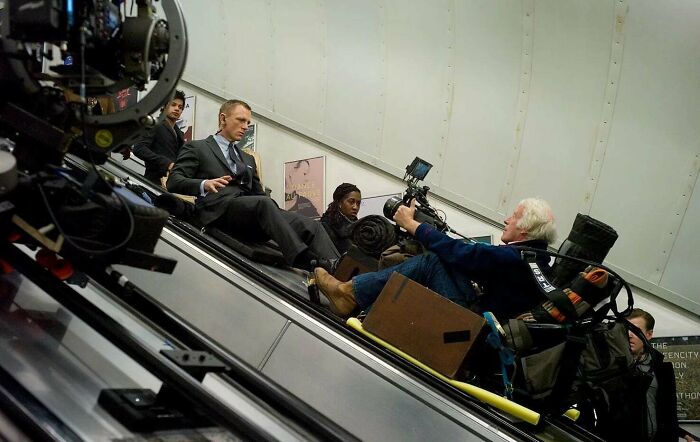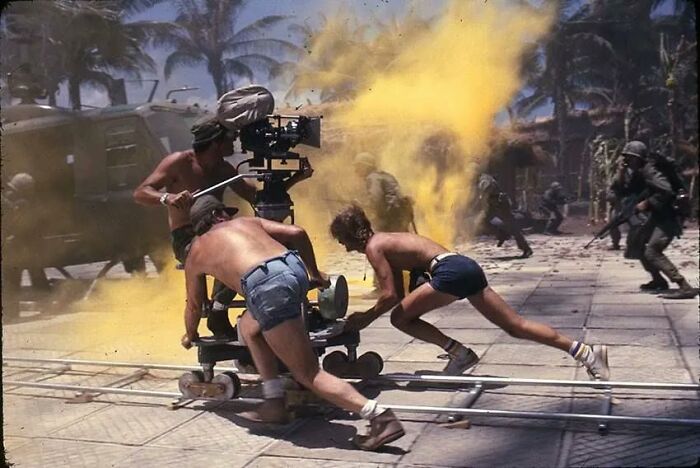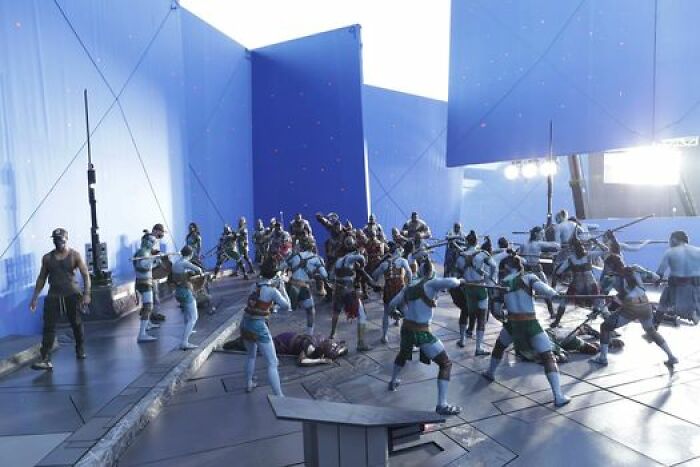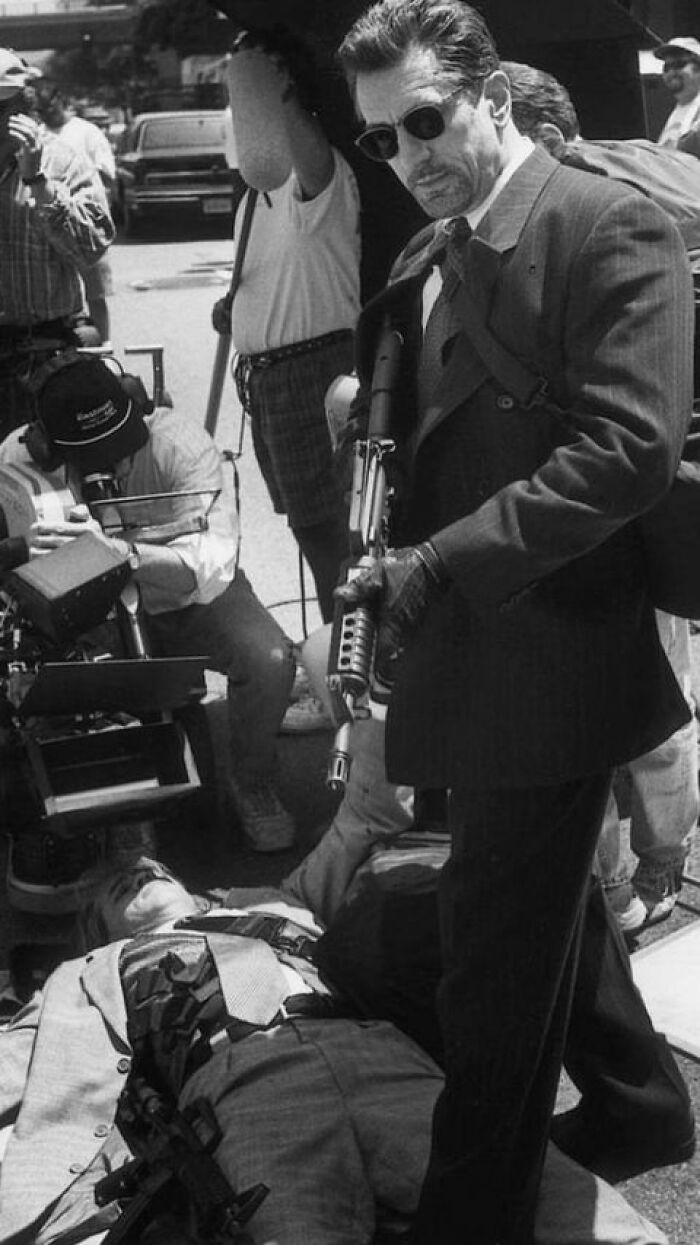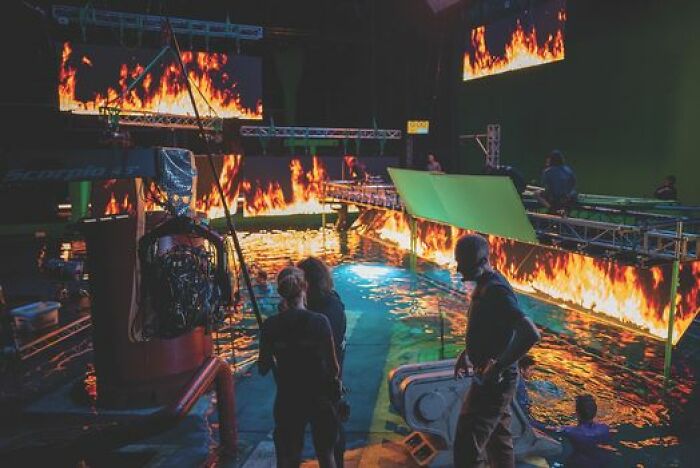
30 Interesting Behind-The-Scenes Pics That Might Give You A New Perspective On Moviemaking, As Shared On This Page
Lights, camera, action! When you imagine a film set, you might picture a demanding person sitting in their classic director’s chair shouting commands at PAs and actors. And of course, there’s always someone holding a clapperboard before each take. But if you're curious about what actually went on behind the scenes of all of your favorite films, you’re in luck.
Down below, you’ll find a list of some of the most fascinating posts from the “Behind the Clapperboard” Facebook page. From pics of Steven Spielberg chilling with Tom Hanks off-screen to shots of the cameramen and women who captured the world's most iconic scenes, we’ve got something for all cinephiles on this list. Enjoy learning a bit more about the film industry, and be sure to upvote the pics you find most fascinating!
This post may include affiliate links.
The Terminator (1984). James Cameron
Cinematography: Adam Greenberg
Terminator Stop Motion: Pete Kleinow
The Hunt For Red October (1990). John McTiernan
Cinematography: Jan de Bont
Photo by: Bruce McBroom
True Lies (1994). James Cameron
Cinematography: Russell Carpenter
Camera Operator: James Cameron
Stunt Coordinator/Arnold Schwarzenegger Stunt Double: Joel Kramer
Jamie Lee Curtis Stunt Double: Jamie Lee Curtis
Photo by: Zade Rosenthal
Jamie Lee Curtis Stunt Double: Jamie Lee Curtis? Amazing, she looks so elegant, I'd be flappy flipping all over the place, while she looks like a ballerina.
The Behind the Clapperboard Facebook page has been around since 2014, sharing a side of some of the most fascinating moments in film history that most of us never get to see. From pictures of iconic directors to reveals of how some of the most memorable moments were recorded, this page has it all. And clearly, it’s captivated many viewers, as it has amassed an impressive 250k followers. The account’s description shares a quote from the beloved Martin Scorsese, stating, “Cinema is a matter of what's in the frame and what's out.” And it certainly does a great job of giving us a glimpse into that “out of frame” side we rarely get to see.
Chances are you love watching films, but have you ever considered why the art of filmmaking is so important to society? According to Paul Jenkins at Brilliantio, watching movies is more than just a fun activity to do on a date or with your best friends on Friday night. (Although, it can be that too!) Ask any cinephile, and they’ll tell you in great detail how much painstaking effort goes into creating a beautiful film. Every choice is well thought out and intentional, and finding all of the brilliant, hidden details is the most exciting part for avid viewers.
Jaws (1975). Steven Spielberg
Cinematography: Bill Butler
Production Designer: Joe Alves
Photo by: Louis Goldman
Star Wars (1977). George Lucas
Cinematography: Gilbert Taylor
Photo by: John Jay
Psycho (1960). Alfred Hitchcock
Cinematography: John L. Russell
Camera Operator: Leonard J. South
Script Supervisor: Marshall Schlom
Photo by: Eugene Cook
Jenkins goes on to note how important films are for pop culture. “Today, film is considered one of America’s most popular art forms and perhaps even its most significant contribution to world culture,” he writes. “It’s hard to imagine what our lives would be like without motion pictures – those flickering images projected on a screen that have become iconic representations of our inner and outer realities, conveying ideas and feelings from one person or culture to another through space and time.”
Filmmaking is also a massive industry worldwide that has provided jobs for thousands of people involved in acting, directing, music making, production, screening, distribution and more. Even producers of popcorn kernels and celluloid raw materials used to print films on reels rely on this industry. And if you’re ever traveled to see the Hollywood Walk of Fame or a Universal Studios tour, you’ve contributed to the movie world’s tourism as well.
E. T. The Extra-Terrestrial (1982). Steven Spielberg
Cinematography: Allen Daviau
Rocky II (1979). Sylvester Stallone
Cinematography: Bill Butler
Steadicam Operator: Garrett Brown
Photo by: Christine M. Loss
The Shining (1980). Stanley Kubrick
Cinematography: John Alcott
Camera Operator: Kelvin Pike
Focus Puller: Douglas Milsome & Maurice Arnold
Films give many of us a way to escape from the monotony of our everyday lives or a way to feel love, wonder and excitement when we’re struggling in our own lives. “Movies are the only art form that allows us to identify with the characters on an emotional level,” Jenkins writes. “We see them as people struggling with real problems and facing real challenges. We live vicariously through them and find our fears, desires, hopes, and aspirations.” Whatever we do or don’t want to experience for a few hours, we can find a film to take us to or out of those places.
Alien (1979). Ridley Scott
Cinematography: Derek Vanlint
Photo by: Bob Penn
Fun fact: the spacesuit wearing actors in this scene are kids, because that made the model look even bigger.
Point Break (1991). Kathryn Bigelow
Cinematography: Donald Peterman
Boom Operator: Geoffrey Patterson
Photo by: Richard Foreman Jr.
Quantum Of Solace (2008). Marc Forster
Cinematography: Roberto Schaefer
Stunt Double: Daniel Craig: Bobby Holland Hanton
Head Stunt Rigger: Diz Sharpe
Photo by: Susan Allnutt
A great film also makes viewers think. There might be messages about social issues, politics, religion, hope, love, triumph, and more that will stretch audiences’ empathy muscles. We can see the world of a character who is completely different from ourselves for a few hours, someone we may have never encountered in our real lives. And films that present these new ideas can be great voices for social change.
“When films about war reflect the real world with gritty realism, rather than showing stylized depictions of soldiers marching into battle under waving flags, they can profoundly affect how viewers think about issues of war and peace,” Jenkins continues. “For example, the movie Saving Private Ryan depicted the horrors of World War II with gruesome special effects; the opening scene focused on the gruesome deaths of several characters-many viewers couldn’t watch it!”
Saving Private Ryan (1998). Steven Spielberg
Cinematography: Janusz Kaminski Photo by: David James
Joker (2019). Todd Phillips
Cinematography: Lawrence Sher
Photo By: Niko Tavernise
Indiana Jones And The Last Crusade (1989). Steven Spielberg
Cinematography: Douglas Slocombe
Camera Assistant: Martin Kenzie
Dolly Grip: Colin Manning
Photo by: Murray Close
Vía Pedro Barnett-College Penella
Prior to the pandemic, in 2019, 792 films were released in the United States and Canada. So clearly, there are hundreds, if not thousands, of directors out there working hard to put their best stories onto the screen. But when it comes to some of the most impactful directors the world has yet to see, Paul Jenkins provides this list: Alfred Hitchcock, Steven Spielberg, Walt Disney, Martin Scorcese, Kathryn Bigelow, Roman Polanski, Jane Campion, George Lucas, Agnés Varda, Brian De Palma, Mira Nair, and Quentin Tarantino. And as far as films that have had a major impact on society, Star Wars, The Sound of Music, To Kill a Mockingbird, Schindler’s List, Star Trek, Taxi Driver, Close Encounters of the Third Kind, Jaws, and Thelma and Louise are some of the world’s favorites.
Skyfall (2012). Sam Mendes
Cinematography: Roger Deakins
Photo by: François Duhamel
Goodfellas (1990). Martin Scorsese
Cinematography: Michael Ballhaus
Camera Operator: David M. Dunlap
Photo by: Barry Wetcher
The Shining (1980). Stanley Kubrick
The Shining (1980). Stanley Kubrick
Cinematography: John Alcott
Damn... even the behind the camera photos are shot perfectly...
As most of us don’t work in the film industry, there are plenty of aspects of the industry that are total mysteries to us. So we consulted this list from New Dawn Films of unique filmmaking facts that you’ve likely never heard before. For example, did you know that both Steven Spielberg and James Cameron never went to film school? “They also both don’t like to recommend students to do it. What they both advocate is for filmmakers to keep practicing and building their reel until they have enough experience to work on paid directing jobs,” the New Dawn team writes.
Apocalypse Now (1979). Francis Ford Coppola
Cinematography: Vittorio Storaro
Camera Operator: Piero Servo
Key Grip: Alfredo Marchetti
Alien (1979). Ridley Scott
Cinematography: Derek Vanlint
Photo by: Bob Penn
Skyfall (2012). Sam Mendes
Cinematography: Roger Deakins
Get out of ze choppah! (And you read it in Arnold’s voice, didn’t you?)
“Being a strong INTJ, Stanley Kubrick actually shot, produced and created his first ever short film project in 1935! He then went on to sell it even though at that time, it was completely unheard of, especially from a relatively unknown filmmaker,” the New Dawn team goes on to write. And when it comes to letting film distributors get sneak peeks of movies, it’s recommended for directors to allow them all to see the film at the same time at the same place. Apparently, if one distributor sees the film and decides it’s not so great, they’ll spread that information like wildfire.
Jaws (1975). Steven Spielberg
Cinematography: Bill Butler
Camera Operator: Michael Chapman
Photo by: Louis Goldman
Return Of The Jedi (1983). Richard Marquand
Cinematography: Alan Hume & Alec Mills
Camera Operator: Peter McDonald
Photo by: Albert Clark
Iron Man (2008). Jon Favreau
Cinematography: Matthew Libatique
Photo by: Zade Rosenthal
As far as sounds in films go, it’s possible that you’ve noticed the same exact ones many times. In fact, there’s one scream in particular that’s been used in over 200 movies: the Wilhelm Scream. Apparently, this iconic sound was recorded over 60 years ago and is often used when a character is shot or falls off a building. The first time this scream was utilized was in the 1951 film Distant Drums, and since then, famous directors like Quentin Tarantino and Peter Jackson have been known to use it.
The Ten Commandments (1956). Cecil B. Demille
Cinematography: Loyal Griggs
OMG. The flood scene. Actors really got washed away in that flood. I don't mean stunt doubles, I mean the main actors.
Poltergeist (1982). Tobe Hooper
Cinematography: Matthew F. Leonetti
Photo by: Bruce McBroom
2001: A Space Odyssey (1968). Stanley Kubrick
Cinematography: Geoffrey Unsworth
We hope you’re enjoying this intimate look into the world of movie making. Be sure to keep upvoting the pics you find most fascinating, and let us know in the comments what your favorite film is and if you know anything about behind the scenes of that shoot. Then, if you’re interested in reading another Bored Panda article featuring surprising movie facts you’ve likely never noticed, look no further than right here!
Superman (1978). Richard Donner
Cinematography: Geoffrey Unsworth
Camera Operator: Peter MacDonald
Photo by: Bob Penn
I mistook him for a tall Danny Devito at first before realizing we were talking about Superman.
Goldeneye (1995). Martin Campbell
Cinematography: Phil Meheux
Photo by: Keith Hamshere
Everything Everywhere All At Once (2022). Daniel Kwan & Daniel Scheinert
Cinematography: Larkin Seiple
Photo by: Allyson Riggs
Nope (2022). Jordan Peele
Cinematography: Hoyte Van Hoytema
Photo by: Leigh Mierke
The Shawshank Redemption (1994). Frank Darabont
Cinematography: Roger Deakins
Photo by: Michael P. Weinstein
Mission: Impossible - Ghost Protocol (2011). Brad Bird
Cinematography: Robert Elswit
Photo by: David James
Edge Of Tomorrow (2014). Doug Liman
Cinematography: Dion Beebe
Camera Operator: Peter Field
Steadicam Operator: Peter Robertson
Boom Operator: Orin Beaton
Photo by: David James
Via Band Pro Film & Digital
The Shining (1980). Stanley Kubrick
Cinematography: John Alcott
Steadicam Operator: Garrett Brown
The Shawshank Redemption (1994). Frank Darabont
Cinematography: Roger Deakins
Photo by: Michael P. Weinstein
Black Panther: Wakanda Forever (2022). Ryan Coogler
Cinematography: Autumn Durald Arkapaw
Back To The Future Part III (1990). Robert Zemeckis
Cinematography: Dean Cundey
Photo by: Ralph Nelson
Odd, how this exact photo is ALSO posted as "Back to the Future Part ll".
Apocalypto (2006). Mel Gibson
Cinematography: Dean Semler
First Assistant Camera: Megan Forste
Home Alone 2: Lost In New York (1992). Chris Columbus
Cinematography: Julio Macat
Photo by: Melinda Sue Gordon
Close Encounters Of The Third Kind (1977). Steven Spielberg
Cinematography: Vilmos Zsigmond
Photo by: Jim Coe
The Godfather (1972). Francis Ford Coppola
Cinematography: Gordon Willis
Photo by: Jack Stager
Se7en (1995). David Fincher
Cinematography: Darius Khondji
Photo by: Peter Sorel
Star Wars (1977). George Lucas
Cinematography: Gilbert Taylor
Camera Operator: Ronnie Taylor
Boom Operator: Ken Nightingall
Continuity: Ann Skinner
Photo by: John Jay
The Revenant (2015). Alejandro G. Iñárritu
Cinematography: Emmanuel Lubezki
Camera Operator: P. Scott Sakamoto
Dolly Grip: Ryan Munro
Top Gun (1986). Tony Scott
Cinematography: Jeffrey L. Kimball
Photo by: Ralph Nelson
Dunkirk (2017). Christopher Nolan
Cinematography: Hoyte Van Hoytema
Photo by: Melinda Sue Gordon
Indiana Jones And The Last Crusade (1989). Steven Spielberg
Cinematography: Douglas Slocombe
Vía Pedro Barnett-College Penella
Back To The Future Part III (1990). Robert Zemeckis
Cinematography: Dean Cundey
Panaglide Operator: Raymond Stella
First Assistant Camera: Clyde E. Bryan
Full Metal Jacket (1987). Stanley Kubrick
Cinematography: Douglas Milsome
Photo by: Gerard Maguire
Blade Runner (1982). Ridley Scott
Cinematography: Jordan Cronenweth
Bridge Of Spies (2015). Steven Spielberg
Cinematography: Janusz Kaminski
Steadicam Operator: Marcus Pohlus
First Assistant Camera: Denny Kortze
Photo by: Jaap Buitendijk
Dunkirk (2017). Christopher Nolan
Cinematography: Hoyte Van Hoytema
Photo by: Melinda Sue Gordon
Apocalypse Now (1979). Francis Ford Coppola
Cinematography: Vittorio Storaro
Glass Onion (2022). Rian Johnson
Cinematography: Steve Yedlin
Photo by: John L. Wilson
The Great Escape (1963). John Sturges
Cinematography: Daniel L. Fapp
Photo by: Lothar Winkler
The Departed (2006). Martin Scorsese
Cinematography: Michael Ballhaus
Camera Operator: Andrew Rowlands
Boom Operator: Andrew Schmetterling
Photo by: Andrew Cooper
The Wolf Of Wall Street (2013). Martin Scorsese
Cinematography: Rodrigo Prieto
Photo by: Mary Cybulski
The Shape Of Water (2017). Guillermo Del Toro
Cinematography: Dan Laustsen
Photo by: Kerry Hayes
Skyfall (2012). Sam Mendes
Cinematography: Roger Deakins
Boom Operator: Orin Beaton
Photo by: François Duhamel
All Quiet On The Western Front (2022). Edward Berger
Cinematography: James Friend
Photo by: Reiner Bajo
The Godfather (1972). Francis Ford Coppola
Cinematography: Gordon Willis
Photo by: Jack Stager
Always (1989). Steven Spielberg
Cinematography: Mikael Solomon
Visual Effects Gaffer: Bob Finley
Visual Effects Key Grip: Dick Dova
Prisoners (2013). Denis Villeneuve
Cinematography: Roger Deakins
Photo by: Wilson Webb
The Night Of The Hunter (1955). Charles Laughton
Cinematography: Stanley Cortez
Thor: Love And Thunder (2022). Taika Waititi
Cinematography: Barry Baz Idoine
Photo by: Jasin Boland
I miss when he used to make quirky movies like Eagle Vs Shark. The world doesn't need more superhero movies, we need more Eagle Vs Shark.
Tenet (2020). Christopher Nolan
Cinematography: Hoyte Van Hoytema
Photo by: Melinda Sue Gordon
2001: A Space Odyssey (1968). Stanley Kubrick
Cinematography: Geoffrey Unsworth
Clapper Loader: John Campbell
Avatar: The Way Of Water (2022). James Cameron
Cinematography: Russell Carpenter
Photo by: Mark Fellman
Via American Cinematographer
I like to imagine that Mr Cameron wiped away a nostalgic tear or two when he got to do another big exciting climax centered around a sinking ship. :p
I have ZERO desire to hang around celebrities, but I would do almost anything to be involved in some kind of capacity to see a movie being made.
I have ZERO desire to hang around celebrities, but I would do almost anything to be involved in some kind of capacity to see a movie being made.

 Dark Mode
Dark Mode 

 No fees, cancel anytime
No fees, cancel anytime 






